During the year and a half after the new home stayed, it had tossed home network several times. It really was that life was tossing, and it probably experienced so many:
Stage 1: Netcom Induction Cooker R6300V2, moving hard disk into a weak power box, light cat bridging, using a router dial, be considered to have a full-house equipment transparent proxy, offline download and other functions. As far as wireless coverage is concerned, only the dining room is available. The main bedroom and the study basically have no signal. Actually, it is still good. The two people in the family are accustomed to 4G Internet access at ordinary times, and they will even think about WiFi when they need it. The problem lies in the temperature of the induction cooker, which has been over 80 degrees Celsius in summer and is really frightening.
 NETGEAR R6300v2 1750M dual-band gigabit 802.11ac wireless router 699 yuan small but the performance does not diminish Jingdong direct link to Wikipedia
NETGEAR R6300v2 1750M dual-band gigabit 802.11ac wireless router 699 yuan small but the performance does not diminish Jingdong direct link to Wikipedia
The second stage: After researching some VLAN knowledge, we entered into an 8-port network management gigabit switch BL-SG108M. Aunt Zhang has a sun list
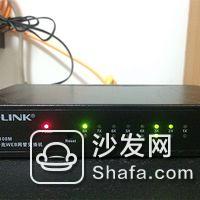 BL-SG108M Gigabit 8-port switch and other tips Note: Multi-map, traffic party be careful because a GEN8 in Aunt Zhang saw a lot of friends with ideas, we all played a lot of similar small toys that are also like-minded A group of people. Speaking of what I'm concerned about, it's worth buying a lot of things since I bought it. I bought a lot of things but I just sent it out in hastily. A beautiful degree watch, write to his wife to see. A Pentax K01 camera that is already on sale, and some braised new potatoes about GEN8 | Like 24 Comments 68 Favorites130 View Details
BL-SG108M Gigabit 8-port switch and other tips Note: Multi-map, traffic party be careful because a GEN8 in Aunt Zhang saw a lot of friends with ideas, we all played a lot of similar small toys that are also like-minded A group of people. Speaking of what I'm concerned about, it's worth buying a lot of things since I bought it. I bought a lot of things but I just sent it out in hastily. A beautiful degree watch, write to his wife to see. A Pentax K01 camera that is already on sale, and some braised new potatoes about GEN8 | Like 24 Comments 68 Favorites130 View Details At the time, the price was in the early 100s and production was suspended for a long time. Now the prices have fallen to double digits. At the time, it was trying to make a one-armed route, using the multiplexing of a single network cable to remove the R6300V2 from the weak box using the trunk solution. However, after a short trial and failed, he never managed to implement multiple VLANs on the WAN port under Merlin's firmware. So he quickly moved to the next stage.
 BL-SG108M_Taobao search Taobao search is the most intelligent commodity search engine, through the operation of big data, accurate understanding of goods and users, to provide accurate personalized search experience. Direct links to s.taobao.com
BL-SG108M_Taobao search Taobao search is the most intelligent commodity search engine, through the operation of big data, accurate understanding of goods and users, to provide accurate personalized search experience. Direct links to s.taobao.com
Phase 3: A Mikrotik RB750Gr2 wired router is placed in the weak box as the main route. This is the smallest 5-port Gigabit I have ever seen. The power is only 3W. At the same time, the R6300V2 was rescued from the weak box and simply used by the AP. Although this basically allows WiFi to cover the entire house, but the cost is not small, although ROS is powerful, it is not like the modified version of Merlin firmware, there is no s*s, remote download and the like, although there are arguments that can be run through the metaRouter The openWrt way curve is implemented, but the RB750Gr2 has only 16MB ROM, this feasibility can not be verified.
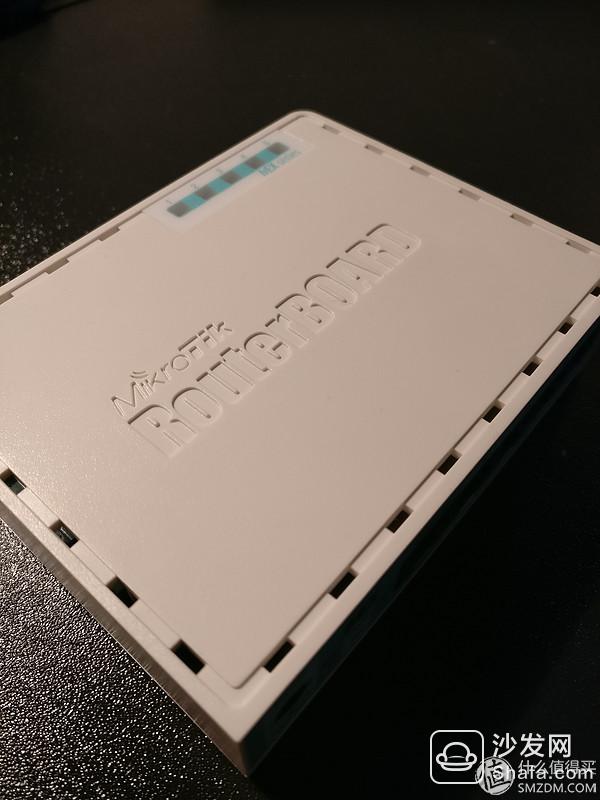
 Mikrotik RB750Gr2_Taobao search Taobao search is the most intelligent product search engine, through the operation of big data, accurate understanding of goods and users, to provide accurate personalized search experience. Direct links to s.taobao.com
Mikrotik RB750Gr2_Taobao search Taobao search is the most intelligent product search engine, through the operation of big data, accurate understanding of goods and users, to provide accurate personalized search experience. Direct links to s.taobao.com The original intention of this toss was to find that the millet sweeping robot at home had lost its connection with sweeping robots. It was found that there was still a blind spot in the WiFi coverage of the home. Although there was not much impact, the obsessive-compulsive disorder could be forced to death!
The easiest way is, of course, to add an AP, anyway, just smart home equipment needs, the bandwidth requirements are not high. However, the problem came, RB750Gr2 has been connected to the living room TV, study PC, R6300V2, occupied three LAN ports, then found that the last LAN port is actually bad ... bad ... bad ... ... this does not Pit people? ! In fact, there are still three bedrooms in the network cable are still idle in the weak box, although temporarily not used, but if it will use it in the days it?
Taking advantage of the rest of the Spring Festival for a few days, I wondered whether I would use the eight-port switch that was previously idle and use it to sort out the tossing goals:
(1) Each room's network cable can access the switch;
(2) The whole house equipment can go through s*s transparent proxy;
(3) Try to make use of idle equipment and not add new equipment (The richest man in the Spring Festival does not give power. Is it Aunt Zhang's style to buy things at a high price in the East?)
I had also done some homework when I tossed the second stage. I also learned a lot about the article on single-arm routing. Which seem to have all mentioned the need for two network management switches. One is placed in a weak box and connected to each room's network cable. The other is placed next to the router. It uses two ports to connect to the WAN and LAN ports of the router. However, it does not want to buy a network management switch any longer, although domestic goods are not expensive. However, it is also an expenditure, not to mention the late electricity charges. It is a word: poor.
(In fact, the router itself has a switching function, through openWrt, DD-WRT should allow the router to act as a switch, in theory, it can be done directly, I am stupid)
This sudden sensation turned its attention to the previously purchased HP Microserver Gen8, saying that this can be used as a home-based All-in-One Homelab, but in fact, I just installed esxi on it and then ran a black skirt. An Ubuntu Server, far from making the best use of it.
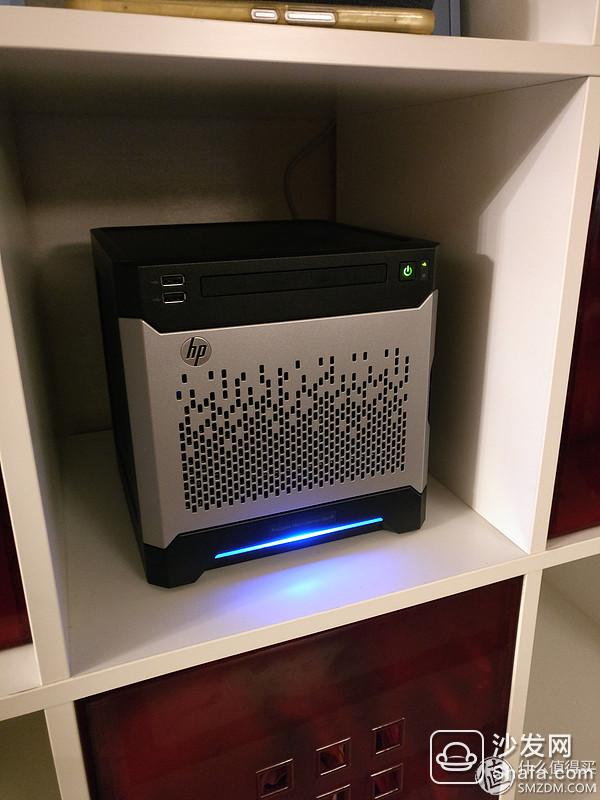
And esxi has a concept of "virtual switch", namely vSwitch. All virtual machines communicate with the physical network card on the device through the vSwitch.

Suddenly a flash of light: can you run a virtual route directly with a virtual machine, and then use the virtual switch and the physical switch in the weak box to realize the trunk, so as to realize the soft route dialing and serve as the gateway of the whole house equipment? The target topology is here:
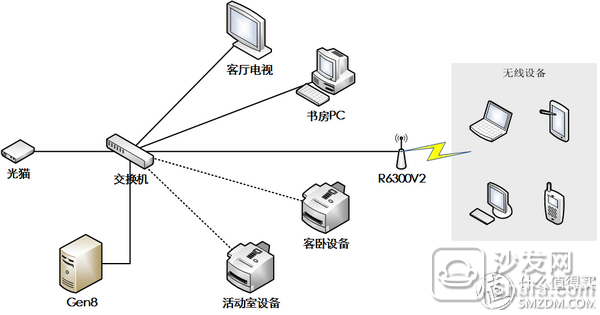 Topology
Topology
After verification, the answer is yes. In fact, I'm just a tossing white guy, so my experience is not optimal. I also welcome masters who don’t want to give guidance.
The physical port assignment on the switch is this:
(1) Port 1 is connected to cats;
(2) Port 2-7 is connected to each room network cable;
(3) Port 8 is connected to Gen8 in the living room, which is the trunk port.
I divided 3 VLANs in total, IDs are 10, 20, and 77, as shown in the figure:
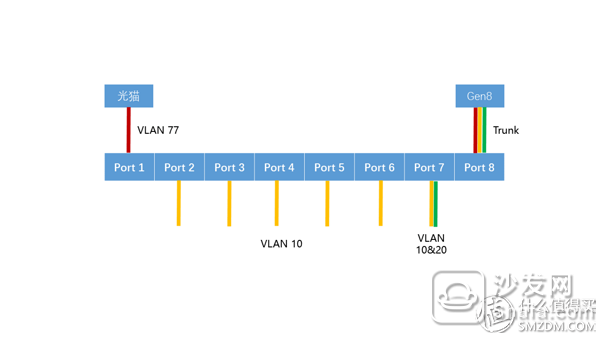
The role of the three VLANs is this:
(1) VLAN 10: General home, can visit the intranet and extranet at the same time;
(2) VLAN 20: For guest use, it can only access the external network and cannot access the internal network.
(3) VLAN 77: Used for communication with optical cats.
Planning to configure it in the switch, have to say, will be linked to the switch configuration interface has a deep stock (tu) ancient (bie) style, as follows:

(1) VLAN 1 is the default management VLAN. It cannot be deleted anyway. It cannot be changed.
(2) VLAN 10 is composed of Port 2-8, in which Port 8 is used as a trunk port for interworking with other VLANs. It is tagged, and the rest of Port 2-7 is set to untagged.
(3) VLAN 20 consists of Port 7-8. Since both ports are designed to run multiple VLANs, they are all tagged.
(4) VLAN 77 consists of Port 1 and 8, Port 8 is trunk, set to tagged, and Port 1 is set to untagged.
Next, the default PVID, that is, the Port-based VLAN ID, is defined. When there is no VLAN information in the data frame header of the switch, the switch automatically adds VLAN information to the data frame according to the set default PVID value. Light cat LAN port, PC will not add VLAN information by default, that is, they all need this. details as follows:

(1) Port 1 is connected to the LAN port of the optical modem. There are no VLANs in the data frame coming out of the port. Therefore, the VLAN ID 77 must be marked by the switch. In addition, only the untagged data frames are allowed to pass through.
(2) Port 2-6 is to connect PCs, notebooks and other devices. These terminal devices generally do not process VLANs. Therefore, the switch needs to add VLAN ID 10, and also sets only untagged data frames to pass.
(3) Port 7 considers that it is necessary to provide general home network and guest network at the same time through the AP, so all data frames are allowed to pass through, default access to the general home network, so PVID = 10, in fact, this mainly depends on the AP to control, this PVID setting actually It is not meaningful;
(4) Port 8 doesn't work well as a trunk port, so I just clicked on it...
Four port groups are divided according to the VLAN settings on the physical switch. The names are LAN (for VLAN 10), LAN_ISO (for VLAN 20), MODEM (for VLAN 77), and Trunk.

It is worth mentioning that the trunk port group, you can see the VLAN ID is 4095, this is actually a esxi a VLAN mode, which is the so-called VGT (Vmware Guest VLAN Tagging).
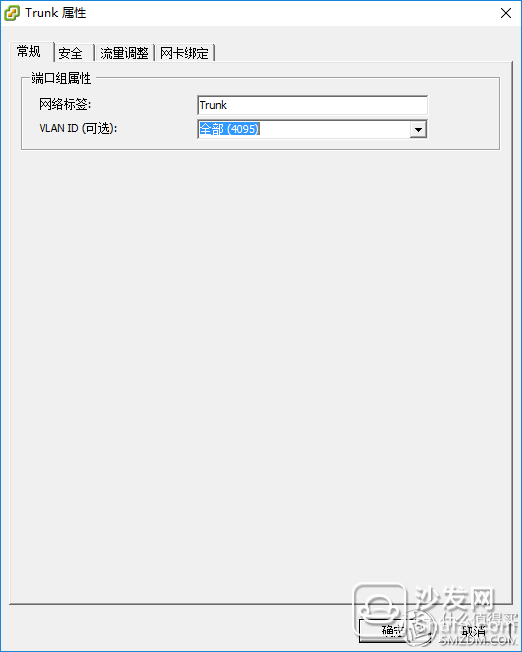
At this point, the esxi host itself does not process the data of the VLAN 4095 port group. Instead, it is handed over to the virtual machine for processing. Although it cannot be set as the physical switch allows only specific VLANs to pass through, it is also enough to be used as the so-called trunk of the CISCO. Now.
Also, remember to keep the management port group. My setup is to allow VLAN 10 to perform esxi management. Strictly, you can set a management VLAN ID separately. If you are concerned, setting a 4095 to allow all VLANs to be managed is not a problem.


I added three network cards directly to the virtual machine, corresponding to three VLANs, that is, one WAN port and two LAN ports. If you want to toss a bit, you can use only one LAN port. The soft route OS controls two VLANs. The effect is actually the same, I'm still lazy.
When the virtual machine is created, it is necessary to choose a soft routing system. The choice is actually quite a few. For example, I love fast, ROS, openWrt, pfSense, etc. I finally chose the LEDE x64 produced by koolshare and used them to stand. The firmware version of Merlin changed for a long time, I feel it is more reliable, and comes with its own s*s, advertising, QoS and other functions, more convenient.
In the k forum can find an esxi applicable vmdk file, although not the latest version, but can be upgraded after the build, it is also very simple. Upload vmdk directly to esxi using WinSCP, then use this vmdk to create a virtual hard disk.
It should be noted that the default gateway IP of LEDE is 192.168.1.1. We may not be able to access the LEDE configuration interface directly on the PC through IP. I used a stupid approach, created a guest, configured a network adapter to connect to the LAN (that is, VLAN 10), and then booted directly from the Ubuntu LiveCD image. At this time, LEDE assigned 192.168.1 to the guest. The IP in the x network segment, and then access the 192.168.1.1 with Firefox in Ubuntu can open the configuration page.

You can set PPPoE account password, DHCP, s*s, etc., and you can use it directly.
4, wiring, enjoy!After all, I was a novice. Before I tried it, I was afraid that the VLAN was misconfigured. As a result, my PC and Gen8 couldn't access each other. It was an egg pain. So I was holding a laptop and a switch sitting next to the weak box. OK, really. Not so scary.
After some configuration in the past, now only need to configure the network cable to the switch according to the VLAN configuration. Port 1 connects the cat, Port 7 connects to R6300V2, and Port 8 connects to Gen8. The other ports are just like and are the same.
This will be done!
It took 3 days now, the network is stable, the transparent proxy is normal, Gen8's CPU usage is not high, and the only one that is currently unavailable is iLO can't access it directly. The soft route running on the Gen8 virtual machine can't be given to the physical port. Redistribute IP, but I don't use iLO very much now, so for the time being, I will try to solve it later.
Now that the RB750Gr2 is idle, when it comes to second-hand use, it can produce more than 100 pieces. It feels like tossing up a family network and using idleness (in fact, there is a lot of new idleness), and even there is a chance to have a salted fish. A little blood back, satisfied.
Thanks for reading. Please pat the god, but please do not hesitate to guide!
Stay tuned!
Steel structures can be used in many industries such as foundation reinforce, electric power transmission structures and tubular scaffolding, etc.
A flange can also be a plate or ring to form
a rim at the end of a pipe when fastened to the pipe. A blind flange is a plate
for covering or closing the end of a pipe. A flange joint is a connection of
pipes, where the connecting pieces have flanges by which the parts are bolted
together.
Although the word flange generally refers to
the actual raised rim or lip of a fitting, many flanged plumbing fittings are
themselves known as 'flanges':
There are many
different flange standards to be found worldwide. To allow easy functionality
and interchangeability, these are designed to have standardised dimensions.
Common world standards include ASA/ASME (USA), PN/DIN (European), BS10
(British/Australian), and JIS/KS (Japanese/Korean). In the USA, ANSI stopped
publishing B16.5 in 1996, and the standard is ASME B16.5
Steel Structures,Steel Structure Building,Classic Steel Structure,Light Steel Structures
Yixing Steel Pole International Trading Co., Ltd , https://www.yx-steelpole.com